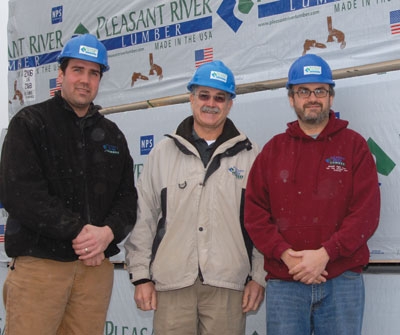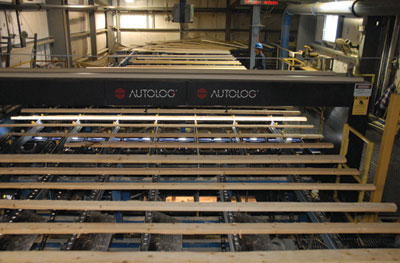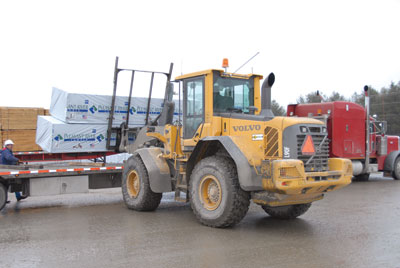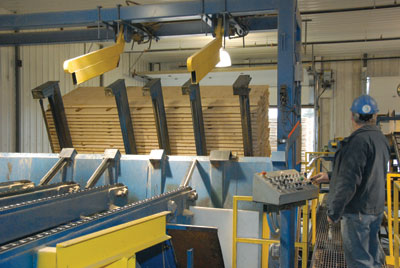
Features
Mills
Sawmilling
Maintaining Consistency
Sometimes you just need to think outside the box to be successful in business. That’s been the order of the day for Jason and Chris Brochu, a pair of brothers who run Pleasant River Lumber in Dover-Foxcroft, Maine with their uncle, Luke Brochu and several other owners.
December 2, 2011 By Bill Tice
 Pleasant River Lumber has worked hard to weather the storm. From left to right are Chris Sometimes you just need to think outside the box to be successful in business. That’s been the order of the day for Jason and Chris Brochu
Pleasant River Lumber has worked hard to weather the storm. From left to right are Chris Sometimes you just need to think outside the box to be successful in business. That’s been the order of the day for Jason and Chris BrochuBy using creativity in their business plans and in the workplace, the trio has kept the sawmill operating through the difficult times currently facing the North American industry. It hasn’t been without challenges, but they have managed to maintain production levels, keep their employees working and invest in the mill with their sights set on economic improvements down the road. And, they have done it all with a ‘can do’ attitude that is now starting to pay dividends.
“We felt the impact of the downturn in the economy and the lower U.S. housing starts, but because of decisions we made early on to continue operating at normal levels, we are now seeing the benefits,” Jason explains. “It was really tough to continue production and build inventory when sales were down, but we made a conscious decision to continue on track, and because of that, we have maintained our markets and our customer base.”
The Brochus say they were able to do this by “focusing on what happens inside our gates” rather than on the external factors they can’t control. “With the external factors, such as lumber prices and market demand, you just have to role with the punches,” Chris says. “Internally, we have a great crew of employees who work hard regardless of the lumber market. We don’t expect our crew to give up pay or work fewer hours to help us get through. They know we are dedicated to them and to keeping them working, and that dedication we have shown to the crew has come right back to us in terms of how they have embraced efficiency in the mill and done whatever is required to keep productivity up.”
That commitment is also evident in the front office where Jason says, “we feel that we have the best internal accounting in the industry,” referring to their team of experienced office personnel and Moe Bisson and Rodney Irish, who are also part owners of the mill. “These guys have developed programs and spread sheets that allow us to see exactly where we are at and what we have to do, and they give us the information we need so that we can make timely decisions.”
Running the Mill
For the most part, Luke, who is the president of Pleasant River Lumber, says he is “hands off” when it comes to production decisions in the mill, leaving the day-to-day operations to Jason and Chris, who are both vice presidents. All three are part of the ownership team, along with Bisson and Irish, Adrien Brochu, who is known as “Dad” to Jason and Chris, and Guy Brochu, who is another uncle to the two younger Brochus. Luke, Adrien and Guy are all brothers who came to Maine as kids from St. Prospere, Que. when their father, Emile, emigrated to the U.S. With the exception of Jason, each of the Brochus is fluent in French and the family roots in Quebec are very strong to this day.
The current group of owners has only been in control of the mill since 2004 when they purchased the facility from Gerard Crete & Fils (Sons) in Proulxville Que., who bought the mill in 1995. From 1980 to 2004, Luke, Guy, Adrien, and Andre Brochu, who passed away in 1993, were co-owners of Stratton Lumber in Western Maine with the Fontaine family of Woburn, Que. Luke had the most experience in the business after spending 25 years as general manager and vice president at the Stratton Lumber dimension mill with Guy serving as operations manager for 20 years. Jason and Chris both attended Bentley University in Boston with Jason, who is the older of the two brothers, returning to Maine on completion of his education to help run a logging and land clearing company for several years before the group acquired the Pleasant River mill. When Chris finished school, he spent a couple of years working for Cherry Mountain Lumber, a hardwood mill in New Hampshire and a subsidiary of the Fontaine Group, before coming home to Maine.
With their strong Canadian ties and their proven track record in working with Canadian partners, the Brochus continue to search for opportunities on both sides of the border. They recently started working with a Canadian value added manufacturer and Jason says they are anticipating strong growth in the partnership. “We will be processing wood for the Canadian company at a value added plant we own and operate in West Enfield, Maine,” he adds.
The Upgrade Path
The Pleasant River mill was originally built in 1970 to produce pine lumber, but after being destroyed by a fire in the early years, it was rebuilt as a spruce mill. In 2005, just a year after the current ownership took over the mill, they started a major upgrade that included the installation of a new Comact wave feeder, a PHL canter twin line and edger, both with Autolog optimization, and PHL handling equipment right through to the sorter. Guy Brochu acted as project manager and most of the installation was handled in house.
With the exception of converting from an oil boiler to a sawdust-fired boiler in 2006, it would be 2008 before they would look at any additional major upgrades at the mill. Jason recalls that it was early that year and all of the owners were at the WoodTech show in Portland, Ore. He says they had heard a lot about optimized grading in the planer mill, and decided to take a closer look at it. “We were focused on the planer, which is the direction most mills have taken. But through our evaluation, Chris came out and said ‘why don’t we look at putting it in the sawmill?’ We started to look at it differently, and then the more we thought about it and the more we put it on paper, the more it made sense.”

Armed with their ideas, Pleasant River approached several suppliers before narrowing it down to two, and then ultimately deciding to work with Autolog from Blainville, Que. on installing a new Color Vision Transverse Optimizer that would be positioned just before the trimmer in the sawmill. At the same time, the Brochus decided to install a new positioning fence from Comact, which is located right after the new optimizer.
Going with Autolog
The decision to go with Autolog for the optimization was made in the fall of 2008 and the equipment was installed in July 2009. Both Jason and Chris say the confidence they have in Autolog and the willingness of Autolog to look at things a little differently came into play when it was decision time. Another factor was the long relationship Luke has had with Autolog throughout his career. “I’ve known the folks at Autolog since they formed the company and over the years I have been involved in many projects with them, so when Chris and Jason approached me with the idea of adding more optimization and using the vision technology in the sawmill, I couldn’t think of anyone better to be involved with on a project such as this than Autolog.”
Jason says the concept they were looking at by positioning the Color Vision Transverse Optimizer in the sawmill was to not allow lumber that would never make it into a wrapped bundle to leave the sawmill. “With the technology that now exists, we can do that,” he explains. “That was more important to us than most mills as our planer mill is still relatively labour intensive and we still use a green chain for our shorter boards.”
Now that trim decisions are being made in the sawmill, a higher percentage of longer boards can go directly to the planer mill’s stacker, which Jason adds, “has reduced the burden on the green chain and has allowed us to operate the planer mill with a smaller crew.”
The new Autolog optimizer is equipped with DPS-824V board scanners from Hermary Opto Electronics Inc., which is based near Vancouver, B.C. The Hermary scanners provide both geometric and colour image scanning of the board as it passes through the scan zone. The Hermary scanners were mounted on an existing scanner frame that housed an older geometric scanner, which helped the mill in terms of budget as only minor changes were required to the board transport system.
The new equipment was initially installed and set-up as a “geometric only” scanner, which meant the hardware could be put in place over a weekend, resulting in no initial downtime for the mill. Over the next three months, the colour and vision aspects of the technology were introduced. “We had a fantastic start-up due to the work of the technicians from Autolog. They worked closely with our team and did a lot of testing to make sure the colour and vision components were giving us the results we expected,” Chris explains. “That meant sending a lot of samples to Autolog and comparing the results from the scanner to what we would achieve with more traditional methods of grading,” adding that the new system “passed the acceptance test” in October of last year.
Mill Flow

The Pleasant River mill is a single line affair with production flow starting in the log yard where 60% of the wood being delivered is tree length. The yard work is done on contract by Madden Timberlands, which typically has a crew of five people on site. They use Serco log handlers and slashers to sort, slash and stack the logs. Pleasant River crews take over production when their Volvo L110 picks up the logs from inventory and delivers them to one of two sawmill infeeds. One of the infeeds is equipped with a Forano (now USNR) 18-inch debarker that Pleasant River purchased last July from a northern Quebec sawmill that had closed. The other infeed has a 30-inch Cambio (now USNR) debarker.
Following the smaller debarker, older Comact wave feeders move the logs forward while a new set of Comact wave feeders installed as part of the 2005 upgrade is situated after the larger debarker. All of the logs end up on a deck prior to the mill’s PHL twin line, which is equipped with Autolog optimization that provides a 3-D log scan. The twin takes off the side boards, which are sent to a PHL optimized edger that also has Autolog scanning and was installed as part of the previous upgrade. The cant continues through a Comact 10-inch curve sawing gang that was installed in the mid-1990s and then all boards, including boards from the edger, meet up at a PHL unscrambler before being processed through the new Autolog Color Vision Scanner. The new Comact positioning fence is next, followed by a trimmer, a 65-bin drop sorter, and a stacker, all from PHL.
From the stacker, the packages are stored in inventory until they are moved to one of three kilns, including two from Irvington Moore (now USNR) – one with a 145,000 board ft. capacity and the other with a 108,000 board ft. capacity. The third kiln is a 145,000 board ft. capacity model from Lexington, N.C.-based SII Dry kilns. Heat for the kilns and mill buildings is produced with a 600 HP IBC sawdust boiler.

The planer infeed is equipped with a Tronco tilt hoist, which is followed by an Irvington Moore pineapple roll infeed, a speed-up section supplied by Atelier Fabrication in Longuevil, Que., and then a Yates planer that was equipped last year with a Key Knife disposable knife system. Following the planer, the product goes through an Irvington Moore drop saw trimmer and then the predominant grade goes to a stacker that was manufactured by the previous mill owners, while trims and downgrades go to the green chain. Most of the product coming off the green chain will be shipped to the company’s West Enfield value-added plant, which is about 30 miles (50 kilometres) away.
A fleet of four leased Volvo L90 loaders handles the lumber in the yard, including loading outgoing lumber trucks.
Company Capacity
In total, the company has the capacity to produce about 100 million board feet of wood products annually. On its current shift structure, which includes two shifts in the sawmill and one shift in both the planer mill and the value-added plant, they run about 90 million board feet. Between the Dover-Foxcroft mill and the value added plant, they can produce 2×3 to 2×10 framing lumber in 6 to 16 ft. lengths and 1×3, 1×4 and 1×6 boards in the same lengths. They employ 87 people, including the owners, staff at the Dover-Foxcroft site and nine employees at the value-added plant. To accommodate the additional volume generated through the recent Canadian value added partnership, plans are under way to add a second shift at the West Enfield plant this spring, which will increase employment by nine people.
Pleasant River Lumber’s products are primarily sold through wholesale distribution and buying groups, mainly to smaller retailers. Jason says they have purposely stayed out of the big box store market and he considers the company to be in a “quality niche” market on the east coast. “We have been very successful in selling our products in the higher end markets because of our quality and consistency,” he explains, adding that they are also Forest Stewardship Council (FSC) certified and about 25% of their output meets FSC standards. Most of the markets for Pleasant River wood are from Baltimore north, but Chris says the poor lumber markets have created favourable transportation costs for western wood so they have been staying even closer to home.
Looking forward, Jason says that in his opinion any mill that is running now has probably seen the worst. “For us, I think we have hit the bottom in terms of losses,” he says. “We can’t control the housing starts and we don’t know where they will go, but here at the mill, we feel the challenging markets have caused us to look at things differently. We are focused and we are well positioned to move forward, no matter what the market throws our way.”
Print this page